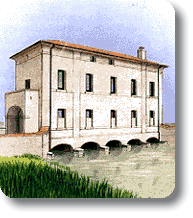 |
The place name recalls an old Gaurus, an historcial branch of the Po river. since the 500, in the mouth, a town on the frame of the port of Abate developed. Today's one originated in the XVIII century on the Po river's right bank in a marshy zone where the cane made"casoni" (fisherman shelters) rose on the backside of the banks. Fishing, and in the recent time, mussel growing are Goro's principal economic activities, that boasts a modern port, a powerful fishing fleet and a highly attended fishing market where daily fish is auctioned and bought by buyers from North Italy and over the border. There are also local industrial transforming products. In the municipal library one can find a section of the Fishing Museum with the relative Teaching Laboratory, that the Commune of Goro wants to finish as soon as possible.
Mussel growing, in particular oyster and clam growing is praticated in the Sacca of Goro, a wide primitive marine loop full of rare naturalistic attractions. The village of Gorino is exclusively for marine life, it's a picturesque and colored village for fishermen, with the houses alligned along the banks of the Po river. It's possible to rent boars for the tour to Sacca here and in Goro.There's an interesting acquarium of the typical fish found in these zones. Gorino Faro is a land band that stretches out to the sea that can be reached only by waterways. The light tower used for the sailors is a recent construction and substitutes the "Old Latern" unusable for the coastal line advancement made in the last decades caused by Padana's contribution. The old handmade building recently restored is a naturalistic observatory on Scanno, a Natural Reserve.
In the hinterland, there are hydraulic water regulating monuments of the land reclamations to attract attention:Torre Palù (XVIII century) and theWater Scooping machine building of Pescarina (XIX century). |
 |
In the 1600's The Palù Tower was built in order to insure the Canal Bianco flow to the sea and the needlessness of the Abate Tower for the lowering of the land and progressive extension of the canal.It's one of the well perserved buildings with five arches with lower curves and Da Vinci's style doors and bulkheads still running. It will hold the Fishing Museum and the Teaching Laboratory, the first sections are gathered in the local Junior high schools of Goro.
The distance that separate Palù Tower from Abate Tower is the exact dimension of the territory that formed the limy deposits of the Po of Goro and of the Canal Bianco in about a one and a half century.
A water regulating building can be easily reached by the provincial road that brings to Goro. Nearby the small water regulating building called "of the woods" ruins are visible.
Going along the Canal Bianco towards the Sacca of Goro, wood relicts of the Romanina can be seen, behind the Gran Bosco of the Mesola, and the few "dossi" of Valle Goara. From the bank one can admire the splendid panorama of the sandbanks and the mouth of the Volano Po.
A few kilometers along the Po's banks a Pescarina waterscooping plant can be found, built in the end of the 1800's with vapor running pumps. |

